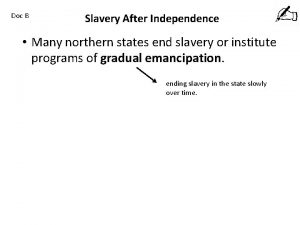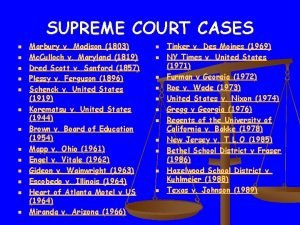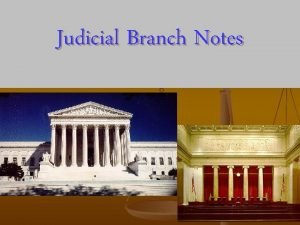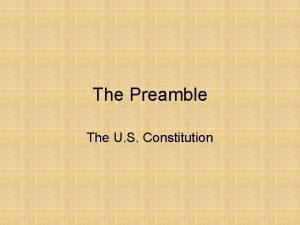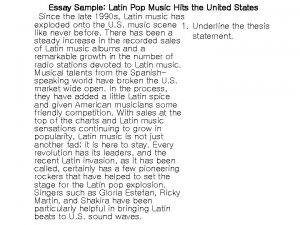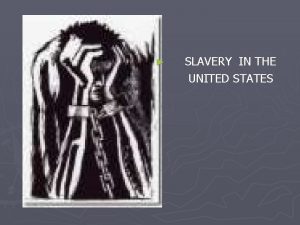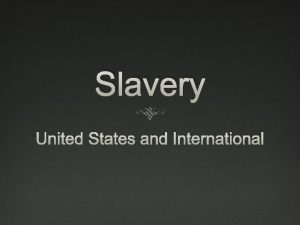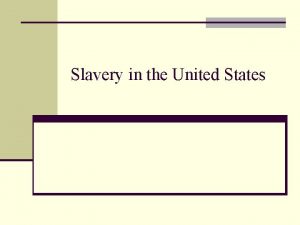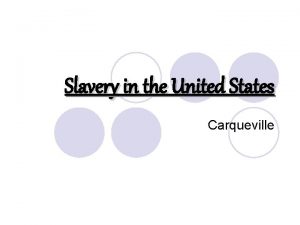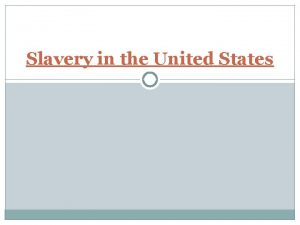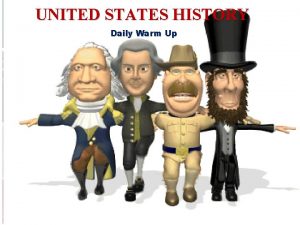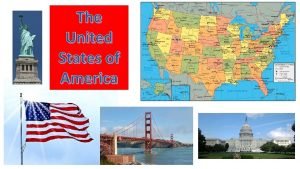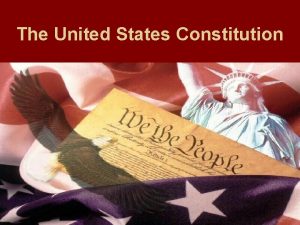SLAVERY IN THE UNITED STATES SLAVERY TIMELINE In































- Slides: 31

► SLAVERY IN THE UNITED STATES

SLAVERY TIMELINE: In 1619, 20 Africans were dropped off by a Dutch trader at Jamestown, Virginia. Slavery did not legally exist in the colony at the time, and the Africans were treated as indentured servants, gaining their freedom after a fixed period of time. In 1654, John Casor, a black man, became the first legally-recognized slave in the area that later became the United States. Casor was owned by one of the original indentured servants, a black colonist named Anthony Johnson. Slavery became formally codified in the English colonies in the second half of the 17 th century. ► The cotton, tobacco, and sugar cane harvested by slaves became important exports for Brazil, the United States and Caribbean island countries. The money generated by this trade was mostly used to support the subsistence of the slaves and expand the lifestyle of the slaveowners. ►

Timeline continued…. . The importation of slaves into the United States was banned in 1808, by which time about 300, 000 had been imported. Subsequent slaves were nearly all born in the United States and the slave population in the United States eventually grew to 4 million by the 1860 Census. In other countries, the slave population barely reproduced itself. From the later eighteenth century, and possibly before that even, and until the Civil War, the rate of natural growth of North American slaves was much greater than for the population of any nation in Europe, and was nearly twice as rapid as that of England. [15] ► By 1800, slavery was abolished in most of the Northern states and many believed it would be soon in the South also. However, following invention of the cotton gin (in 1793), cotton became the main cash crop of the South and slave labor became the backbone of the Southern oligarchy and its plantation lifestyle. Slavery in the United States also had important political implications. During the westward expansion of the United States during the early and mid 1800 s, many Northerners, thoroughly detesting the institution of slavery, tried to prevent its expansion into new territories and new states entering the Union. Attempts by the North to exclude slavery from these lands angered the South and helped lead to the American Civil War in 1861. ►

Coming to the U. S. An estimated 15 million Africans were transported to the Americas between 1540 and 1850. To maximize their profits slave merchants carried as many slaves as was physically possible on their ships. Ships were built to carry a maximum of 451 people, but was carrying over 600 slaves from Africa to the Americas. Chained together by their hands and feet, the slaves had little room to move. It has been estimated that only about half of the slaves taken from Africa became effective workers in the Americas. A large number of slaves died on the journey from diseases such as smallpox and dysentery. Others committed suicide by refusing to eat. Many of the slaves were crippled for life as a consequence of the way they were chained up on the ship. By the 17 th century slaves could be purchased in Africa for about $25 and sold in the Americas for about $150. After the slave-trade was declared illegal, prices went much higher. Even with a death-rate of 50 per cent, merchants could expect to make tremendous profits from the trade.

► Look at the next 3 slides. ► These are examples of slave ships. ► Consider the following: § What might it have been like to be on that boat? § What were the ship owners trying to do?

Slave ships




► FAMILIES AND SLAVE TRADE Plantation owners in America had complete freedom to buy and sell slaves. State laws gave slave marriages no legal protection and in these transactions husbands could be separated from their wives and children from their mothers. In his autobiography, Frederick Douglass claimed that in the part of Maryland where he was born: "to part children from their mothers at a very early age. Frequently, before the child has reached its twelfth month, its mother is taken from it, and hired out on some farm a considerable distance off. " The owner of Harriet Jacobs used the threat of selling her children as a means of controlling her behavior. In her book, Incidents in the Life of a Slave Girl, Jacobs described how one mother, who had just witnessed seven of her children being sold at a slave-market: "She begged the trader to tell her where he intended to take them; this he refused to do. How could he, when he knew he would sell them, one by one, wherever he could command the highest price? I met that mother in the street, and her wild, haggard face lives to-day in my mind. She wrung her hands in anguish, and exclaimed, 'Gone! All gone! Why don't God kill me? ' I had no words wherewith to comfort her. " A study of slave records by the Freedmen's Bureau of 2, 888 slave marriages in Mississippi (1, 225), Tennessee (1, 123) and Louisiana (540), revealed that over 32 per cent of marriages were dissolved by masters as a result of slaves being sold away from the family home. ► Having babies - The death-rate amongst slaves was high. To replace their losses, plantation owners encouraged the slaves to have children. Child-bearing started around the age of thirteen, and by twenty the women slaves would be expected to have four or five children. To encourage child-bearing some population owners promised women slaves their freedom after they had produced fifteen children. Young women were often advertised for sale as "good breeding stock". To encourage child-bearing some population owners promised women slaves their freedom after they had produced fifteen children. One slave trader from Virginia boasted that his successful breeding policies enabled him to sell 6, 000 slave children a year.

§ At age 5, slave children were expected to work on a plantation.



FOOD, CLOTHING, AND SHELTER FOOD: One bushel of corn meal a month plus eight pounds of pork or fish. Some plantation owners gave their slaves a small piece of land where they could grow vegetables. ► CLOTHING: Slaves has a yearly clothing allowance. “Two coarse linen shirts, one pair of linen trousers, like the shirts, one jacket, one pair of trousers for winter, one pair of stockings, and one pair of gloves. For the winter, slaves were given an overcoat, a wool-hat once in two or three years and a pair of coarse shoes. ” ► SHELTER: Usually consisted of wooden shacks with dirt floors. The houses were built to house two families. In a single room were huddled, like cattle, ten or a dozen persons, men, women, and children. They did not have beds, nor furniture of any kind. Their beds were a collection of straw and old rags, thrown down in the corners and boxed in with boards – only a single blanket as covering. ►



House v. Field slaves ► House slaves -House slaves usually lived better than field slaves. They usually had better food and were sometimes given the family's cast-off clothing. However, not all slave-owners took this view, Harriet Jacobs reports that her mistress "would station herself in the kitchen, and wait till it was dished, and then spit in all the kettles and pans" to make sure that the slaves did not eat what was left over. Their living accommodation was also better than those of other slaves. In some cases the slaves were treated like the slave-owners children. When this happened close bonds of affection and friendship usually developed. Even though it was illegal, some house slaves were educated by the women in the family. Trusted house slaves who had provided good service over a long period of time were sometimes promised their freedom when their master's died. ► Slaves were in the fields from sunrise to sunset and at harvest time they did an eighteen hour day. Women worked the same hours as the men and pregnant women were expected to continue until their child was born. Only a month's rest was allowed for recovery from child-bearing. The women then carried the child on their backs while they worked in the fields. Around the age of five, slave children would also be expected to work on the plantation.

OVERSEERS ► In 1860 it was calculated that about 88 per cent of America's slave-owners owned twenty slaves or less. However, large landowners would usually own well over 100 slaves and relied heavily on overseers to run their plantations. These overseers were under considerable pressure from the plantation owners to maximize profits. They did this by bullying the slaves into increasing productivity. The punishments used against slaves judged to be under-performing included the use of the cart-whip. Not surprisingly the mortality-rate amongst the slaves was high. Studies have shown that over a four-year period, up to 30 per cent of the slave population in America died.

► SLAVE PUNISHEMENTS The law provided slaves with virtually no protection from their masters. On large plantations this power was delegated to overseers. These men were under considerable pressure from the plantation owners to maximize profits. They did this by bullying the slaves into increasing productivity. The punishments used against slaves judged to be under-performing included the use of the whip. Sometimes slave-owners resorted to mutilating and branding their slaves. Some punishments were associated with certain areas. According to William Wells Brown, slave owners in Virginia smoked slaves. This involved whipping slaves and putting them in a tobacco smoke-house. " Moses Roper claimed that in South Carolina they used to "drive nails into a hogshead so as to leave the point of the nail just protruding in the inside of the cask. Into this he used to put his slaves for punishment, and roll them down a very long and steep hill. " Lewis Clarke, a house slave in Kentucky, described in his autobiography the different methods used by his mistress: "instruments of torture were ordinarily the raw hide, or a bunch of hickory-sprouts seasoned in the fire and tied together. But if these were not at hand, nothing came amiss. She could relish a beating with a chair, the broom, tongs, shovel, shears, knife-handle, the heavy heel of her slipper, and an oak club, a foot and a half in length and an inch and a half square. With this delicate weapon she would beat us upon the hands and upon the feet until they were blistered. " States with large numbers of slaves introduced their own slave codes. The main idea behind these codes was to keep the slaves under the tight control of their owners. The death-penalty was introduced for a whole range of offences. Slaves could be executed for murder, rape, burglary, arson and assault upon a white person. Plantation owners believed that this severe discipline would make the slaves too scared to rebel.

Thomas Johnson with slave whip and chains


ESCAPE! Slaves constantly talked about the possibility of escape: "there arose in some an irrepressible desire for freedom which no danger or power could restrain, no hardship deterred, and no bloodhound could alarm. This desire haunted them night and day; they talked about it to each other in confidence; they knew that the system which bound them was as unjust as it was cruel, and that they ought to strive, as a duty to themselves and their children, to escape from it".

► The main problem was having to leave family and friends. Henry Bibb wrote in his autobiography that it was "one of the most self-denying acts of my whole life, to take leave of an affectionate wife, who stood before me on my departure, with dear little Frances in her arms, and with tears of sorrow in her eyes as she bid me a long farewell. " They also knew that there was the possibility that if they evaded capture, their closest relatives would be severely punished. They also knew that successful escapes were rare. Slaveowners used bloodhounds to trace their slaves. Problems of finding food and shelter in a hostile environment and the absence of maps were also other factors in understanding why most slaves failed in their bids for freedom. Moses Grandy explained the problems that runaways faced: "They hide themselves during the day in the woods and swamps; at night they travel, crossing rivers by swimming, or by boats they may chance to meet with, and passing over hills and meadows which they do not know; in these dangerous journeys they are guided by the north-star, for they only know that the land of freedom is in the north. They subsist on such wild fruit as they can gather, and as they are often very long on their way, they reach the free states almost like skeletons. " Within a few days of leaving the plantation most runaways were brought back and heavily punished. Francis Fredric was free for nine weeks but was captured and received 107 strokes of the whip. Moses Roper, received 200 lashes and this was only brought to an end when the master's wife pleaded for his life to be spared. A study of runaway notices of local newspapers revealed that 76 per cent of all fugitives were under 35, and 89 per cent of them were men. Another study suggested that field slaves were more likely to try and escape than house slaves

THE UNDERGROUND RAILROAD ► ► ► The development of the underground railroad increased the number of slaves who were able to reach safety. By the middle of the 19 th century it was estimated that over 50, 000 slaves had escaped from the South using this method. Plantation owners became so concerned by these losses that in 1850 they managed to persuade Congress to pass the Fugitive Slave Act. In future, any federal marshal who did not arrest an alleged runaway slave could be fined $1, 000. Any person aiding a runaway slave by providing shelter, food or any other form of assistance was liable to six months' imprisonment and a $1, 000 fine. The Underground Railroad was the name given to the system by which escaped slaves from the South were helped in their flight to the North. It is believed that the system started in 1787 when Isaac T. Hopper, a Quaker, began to organize a system for hiding and aiding fugitive slaves. Opponents of slavery allowed their homes, called stations, to be used as places where escaped slaves were provided with food, shelter and money. The various routes went through 14 Northern states and Canada. It is estimated that by 1850 around 3, 000 people worked on the underground railroad. The underground railroad also had people known as conductors who went to the south and helped guide slaves to safety. One of the most important of these was the former slave, Harriet Tubman. She made 19 secret trips to the South, during which she led more than 300 slaves to freedom. Tubman was considered such a threat to the slave system that plantation owners offered a $40, 000 reward for her capture. Stations were usually about twenty miles apart. Conductors used covered wagons or carts with false bottoms to carry slaves from one station to another. Runaway slaves usually hid during the day and traveled at night. Some of those involved notified runaways of their stations by brightly lit candles in a window or by lanterns positioned in the front yard. By the middle of the 19 th century it was estimated that over 50, 000 slaves had escaped from the South using the underground railroad.



FUGITIVE SLAVE ACT ► Plantation owners became concerned at the large number of slaves escaping to the North and in 1850 managed to persuade Congress to pass the Fugitive Slave Act. In future, any federal marshal who did not arrest an alleged runaway slave could be fined $1, 000. Any person aiding a runaway slave by providing shelter, food or any other form of assistance was liable to six months' imprisonment and a $1, 000 fine. The Fugitive Slave Act failed to stop the underground railroad. Thomas Garrett, the Delaware station-master, paid more than $8, 000 in fines and Calvin Fairbank served over seventeen years in prison for his antislavery activities. Whereas John Fairfield, one of the best known of the white conductors, was killed working for the underground railroad

FAMOUS AFRICAN AMERICANS

SOJOURNER TRUTH ► Sojourner Truth (originally named Isabella Baumfree), was born a slave in Ulster County, New York State, in about 1797. At the age of nine she was auctioned off to an Englishman named John Nealey. Over the next few years she was owned by a fisherman in Kingston and then by John Dumont, a plantation owner from New York County. Between 1810 and 1827 she had five children with a fellow slave. She was dismayed when one of her sons was sold to a plantation owner in Alabama. After New York State abolished slavery in 1827, Quaker friends helped her win back her son through the courts. She moved to New York City and obtained worked as a servant. She became friends with Elijah Pierson, a religious missionary, and eventually moved into his home. ► In 1843 Isabella took the name Sojourner Truth. With the help of a white friend, Olive Gilbert, she published her book, The Narrative of Sojourner Truth. Over the next few years Truth toured the country making speeches on slavery. When a white man told her that her speeches were no more important than a fleabite, she replied, "Maybe not, but the Lord willing, I'll keep you scratching. " At the beginning of the American Civil War, she helped recruit black men to help the war effort. In 1864 she moved to Washington where she organized a campaign against the policy of not allowing blacks to sit with whites on trains. As a result of this, she was received in the White House by President Abraham Lincoln. Sojourner Truth died at Battle Creek, Michigan, on 26 th November, 1883.

FREDRICK DOUGLAS ► Frederick Washington Bailey, the son of a white man and a black slave, was born in Tukahoe, Maryland, on 7 th February, 1817. He never knew his father and was separated from his mother when very young. He lived with his grandmother on a plantation until the age of eight, when he was sent to Hugh Auld in Baltimore. The wife of Auld defied state law by teaching him to read. When Auld died in 1833 Frederick was returned to his Maryland plantation. In 1838 he escaped to New York City where he changed his name to Frederick Douglass. He later moved to New Bedford, Massachusetts, where he worked as a labourer. Douglass made many speeches by 1841 and was a great success in this work. In 1845 the society helped him publish his autobiography, the Narrative of the Life of Frederick Douglass. After the publication of his book, Douglass was afraid he might be recaptured by his former owner and so he traveled to Britain where he lectured on slavery. While in Britain he raised the funds needed to establish his own anti-slavery newspaper, the North Star. ► During the Civil War Douglass tried to persuade President Abraham Lincoln that former slaves should be allowed to join the Union Army. After the war Douglass campaigned for full civil rights former slaves and was a strong supporter of women's suffrage. Douglass held several public posts including assistant secretary of the Santo Domingo Commission (1871), Marshall of the District of Columbia (1877 -1881) and U. S. minister to Haiti (1889 -1891). In 1881 he published the Life and Times of Frederick Douglass died in Washington on 20 th February, 1895.

HARRIET TUBMAN ► Harriet Tubman was born a slave in Dorchester County, Maryland in about 1820. In 1848 Tubman decided to try and escape from her plantation. Her husband, John Tubman, refused to go with her as he believed it was too dangerous. Her two bothers accompanied her but later they became frightened and decided to return to the plantation. Tubman made her way north by the Underground Railroad. Later, Tubman returned to rescue the rest of the family. This was the first of 19 secret trips she made to the South, during which she guided more than 300 slaves to freedom. Tubman's activities became so notorious that plantation owners offered a $40, 000 reward for her capture. A supporter of John Brown and his insurrection at Harper's Ferry in 1859, she was so disappointed by its failure that she began an intensive speaking tour of the North. In her speeches she not only advocated an end to slavery but argued for women's suffrage. During the American Civil War Tubman worked as a nurse, scout and an intelligence agent for the Union Army. Tubman's former activities as a conductor on the Underground Railroad made her especially useful as a scout during the conflict. ► With the help of Sarah Bradford, she wrote her autobiography, Harriet Tubman, the Moses of Her People , (1869). With the royalties from the book and a small pension from the United States Army she purchased a house in Auburn, New York and turned it into a home for the aged and needy. Harriet Tubman died on 10 th March, 1913.
 Slavery states map
Slavery states map Gender empowerment measure
Gender empowerment measure Mapp v ohio
Mapp v ohio Does canada have mountains
Does canada have mountains Facts about the ffa emblem
Facts about the ffa emblem Judicial branch
Judicial branch How did these events affect the united states
How did these events affect the united states What the united states has fought for
What the united states has fought for What is the message
What is the message Plessy v ferguson summary
Plessy v ferguson summary President help wanted ad
President help wanted ad North central america
North central america The united states ought to provide a universal basic income
The united states ought to provide a universal basic income Kentucky primary care association
Kentucky primary care association 7 regions of the united states
7 regions of the united states Activity 2 let's review
Activity 2 let's review What states are west of the mississippi river
What states are west of the mississippi river Howland island
Howland island Us core data for interoperability
Us core data for interoperability Usa map latitude longitude
Usa map latitude longitude United states v. cruikshank apush
United states v. cruikshank apush Preamble of usa
Preamble of usa United states government principles in practice
United states government principles in practice Latin pop music hits the united states
Latin pop music hits the united states Expansion of the united states of america 1607 to 1853 map
Expansion of the united states of america 1607 to 1853 map Vietnamese government
Vietnamese government United states map with longitude and latitude lines
United states map with longitude and latitude lines Usa pro soccer
Usa pro soccer Aiesec united states
Aiesec united states We have pacified some thousands of the islanders
We have pacified some thousands of the islanders Polovtsian
Polovtsian Why did the united states imperialize
Why did the united states imperialize
